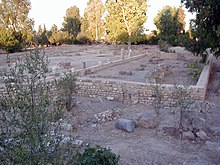
Back رئاسة أسقفية قرطاج Arabic رئاسة اسقفية قرطاج ARZ Arquebisbat de Cartago Catalan Titularerzbistum Karthago German Arquidiócesis de Cartago Spanish اسقفنشینی کارتاژ Persian Archidiocèse de Carthage French בישופות קרתגו HE Arcidiocesi di Cartagine Italian Titulärarzbisdom Cartagine NDS
It has been suggested that 1518 revival be split out into another article titled Roman Catholic Archdiocese of Tunis. (Discuss) (February 2025) |
It has been suggested that portions of Christianity in the Roman Africa province be split from it and merged into this article. (Discuss) (February 2025) |
Archdiocese of Carthage Archidioecesis Carthaginensis | |
|---|---|
| Bishopric | |
 Early Christian quarter in ancient Carthage | |
| Incumbent: Cyriacus of Carthage (last residing ca. 1070) Agostino Casaroli (last titular archbishop 1979) | |
| Location | |
| Country | Roman Empire Vandal Kingdom Byzantine Empire Umayyad Caliphate Abbasid Caliphate Fatimid Caliphate French protectorate of Tunisia Tunisia |
| Ecclesiastical province | Early African church |
| Metropolitan | Carthage |
| Headquarters | Carthage |
| Coordinates | 36°51′10″N 10°19′24″E / 36.8528°N 10.3233°E) |
| Information | |
| Denomination | Catholic Church |
| Sui iuris church | Latin Church |
| Rite | African Rite |
| Established | 2nd century |
| Dissolved | In partibus infidelium in 1519 |
| Leadership | |
| Pope | Francis |
| Titular archbishop | Vacant since 1979 |
The Archdiocese of Carthage is a Latin Catholic titular see originally established as a diocese in Carthage, Roman Empire, in the 2nd century. Agrippinus was the first named bishop, appointed around 230 AD.
The diocese, in its earlier form, was to the Early African church what the Diocese of Rome was to the Catholic Church in Italy.[1] The archdiocese used the African Rite, a variant of the Western liturgical rites in Latin language, possibly a local use of the primitive Roman Rite. Famous figures include Saint Perpetua, Saint Felicitas, and their Companions (died c. 203), Tertullian (c. 155–240), Cyprian (c. 200–258), Caecilianus (floruit 311), Saint Aurelius (died 429), and Eugenius of Carthage (died 505). Tertullian and Cyprian are both considered Latin Church Fathers of the Latin Church.
Tertullian, a theologian of part Berber descent, was instrumental in the development of trinitarian theology, and was the first to apply Latin language extensively in his theological writings. As such, Tertullian has been called "the father of Latin Christianity"[2][3] and "the founder of Western theology."[4] Carthage remained an important center of Christianity, hosting several councils of Carthage.
Carthage exercised informal primacy as an archdiocese, being the most important center of Christianity in the whole of Roman Africa, corresponding to most of today's Mediterranean coast and inland of Northern Africa. As such, it enjoyed the title of primate of Africa:
In the 6th century, turbulent controversies in teachings affected the diocese: Donatism, Arianism, Manichaeism, and Pelagianism. Some proponents established their own parallel hierarchies.
The city of Carthage fell to the Muslim conquest of the Maghreb with the Battle of Carthage (698). The episcopal see remained but Christianity declined under persecution. The last resident bishop, Cyriacus of Carthage, was documented in 1076. It became a titular see with bishops appointed beginning in the 16th century, was briefly restored as a residential see in the 19th century, and was again made titular in 1964, being supplanted by the Archdiocese of Tunis. The titular see of Carthage has been vacant since 1979.
- ^ Plummer, Alfred (1887). The Church of the Early Fathers: External History. Longmans, Green and Company. pp. 109.
church of africa carthage.
- ^ Benham, William (1887). The Dictionary of Religion. Cassell. pp. 1013.
- ^ Ekonomou 2007, p. 22.
- ^ Gonzáles, Justo L. (2010). "The Early Church to the Dawn of the Reformation". The Story of Christianity. Vol. 1. New York: HarperCollins Publishers. pp. 91–93.